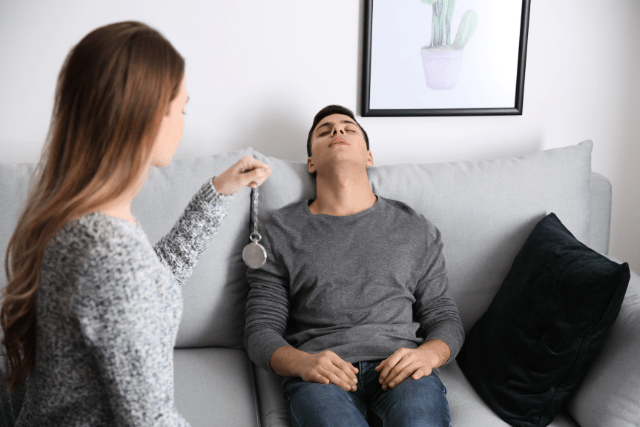Insomnia is a common sleep disorder characterized by difficulty falling asleep, staying asleep, or experiencing non-restorative sleep. It can significantly impact an individual’s quality of life, productivity, and overall well-being.
While various treatment options are available for insomnia, one approach that has gained attention is hypnotism.
This article aims to provide a detailed review of how hypnotism can help combat insomnia, drawing on relevant research studies and expert opinions.
Understanding Hypnotism
Hypnotism, also known as hypnotherapy, is a therapeutic technique that involves inducing a trance-like state to promote relaxation, focus, and suggestibility (Sharma & Andrade, 2012).
It is often used as an adjunctive treatment for various conditions, including insomnia. Hypnotism can be administered by a trained professional or through self-hypnosis techniques.
Hypnotism Techniques for Insomnia
Hypnotism techniques for insomnia induce a relaxed and receptive state in individuals, helping them overcome sleep disturbances.
Let’s dive deeper into these techniques to understand how they work:
- Induction: This initial step is crucial for guiding the individual into a hypnotic state. It typically involves relaxation exercises that promote a sense of calm and tranquillity. Two common methods are:
- Progressive Muscle Relaxation: The hypnotist may ask the individual to tense and then release various muscle groups progressively, starting from the toes and moving up to the head. This helps release physical tension and prepares the body for relaxation.
- Deep Breathing: Controlled deep breathing exercises can induce relaxation by calming the nervous system. The individual is encouraged to take slow, deep breaths, focusing on each inhalation and exhalation.
- Suggestion: Once the individual is in a deep state of relaxation, the hypnotist introduces positive suggestions related to sleep. These suggestions are tailored to address the specific sleep issues the individual is experiencing. Common sleep-related suggestions include:
- Visualizing a Peaceful Sleep Environment: The individual may be encouraged to imagine a serene and comfortable sleep environment, such as a tranquil beach or a cozy bedroom, to promote safety and relaxation.
- Imagining Restful Sleep: The hypnotist may guide the individual in visualizing a restful night’s sleep, emphasizing comfort and security.
- Letting Go of Sleep-related Anxieties: Addressing sleep-related anxieties or worries is crucial. The hypnotist may suggest releasing these concerns and replacing them with a sense of calm and confidence about sleeping.
- Deepening: To maximize the effectiveness of the hypnotic suggestions, the hypnotist may deepen the hypnotic state. This is done by further enhancing relaxation and receptivity. Techniques commonly used for deepening include:
- Countdowns: The hypnotist may count down from a higher number to a lower one, encouraging deeper relaxation with each count.
- Guided Imagery: Intriguing visualizations or scenarios that deepen relaxation and focus.
- Progressive Relaxation: A variation of the initial induction, this phase may involve a more comprehensive relaxation of the body, ensuring that every muscle is fully at ease.
- Awakening: After the hypnotic work is complete, the hypnotist guides the individual out of the hypnotic state. This is essential to ensure they return to full awareness. During this phase, the hypnotist may use a “wake-up” suggestion, encouraging the individual to feel refreshed and alert as they emerge from the hypnotic state.
It’s important to note that while hypnotism can be a valuable tool in managing insomnia, its effectiveness varies from person to person.

Success depends on factors such as the individual’s responsiveness to hypnotic suggestions, the skill of the hypnotherapist, and the underlying causes of their insomnia.
Behavioral Interventions for Insomnia
Behavioural interventions are an essential component of insomnia treatment. They focus on modifying behaviours and thoughts that contribute to sleep difficulties.
Several behavioural interventions effectively manage insomnia, including relaxation training, stimulus control therapy, sleep restriction therapy, sleep hygiene, paradoxical intention therapy, cognitive restructuring, and other approaches (Sharma & Andrade, 2012).
These interventions can be combined with hypnosis to enhance their effectiveness.
Effectiveness of Hypnotics
Hypnotic medications are commonly prescribed for insomnia management. However, the effectiveness of these medications has been a subject of debate.
Research studies have shown that popular hypnotics offer little to no benefit to patients in recommended doses.
The American Academy of Sleep Medicine’s Clinical Guideline for Management of Chronic Insomnia emphasizes the importance of increasing sleep quantity and enhancing daytime function, which is not adequately achieved by hypnotics.
Additionally, hypnotics may cause next-day functional impairment and other adverse effects (Kripke, 2018).
Hypnotism and Psychological Well-being
One of the significant benefits of hypnosis in combating insomnia is its positive impact on psychological well-being. Studies have shown that hypnosis can improve sleep quality, reduce cognitive impairments, and alleviate depressive moods in patients with insomnia (Chang & Chun, 2020).
By addressing the underlying psychological factors contributing to insomnia, hypnotism can promote a sense of calmness, relaxation, and overall mental well-being.

Combining Hypnotism with Cognitive Behavioral Therapy
Cognitive Behavioral Therapy for Insomnia (CBT-I) is considered the gold standard treatment for insomnia. It focuses on identifying and modifying negative thoughts and behaviours perpetuating sleep difficulties.
Recent research has explored the integration of hypnotism with CBT-I, showing promising results. A pilot randomized controlled trial found that a web-based CBT-I program enhanced by acceptance and commitment therapy processes reduced hypnotic dependence and improved sleep quality (Chapoutot et al., 2020).
This suggests combining hypnotism with CBT-I can provide a comprehensive approach to managing insomnia.
Conclusion
Hypnotism can be a valuable tool in the treatment of insomnia. By addressing the psychological aspects of sleep difficulties and promoting relaxation, hypnotism can help individuals achieve better sleep quality and overall well-being.
However, it is important to note that hypnotics, commonly prescribed medications for insomnia, may not offer significant benefits and can have adverse effects.
Therefore, a holistic approach that combines behavioural interventions, including hypnotism, with evidence-based therapies like CBT-I is recommended to manage insomnia effectively.














Leave a Reply